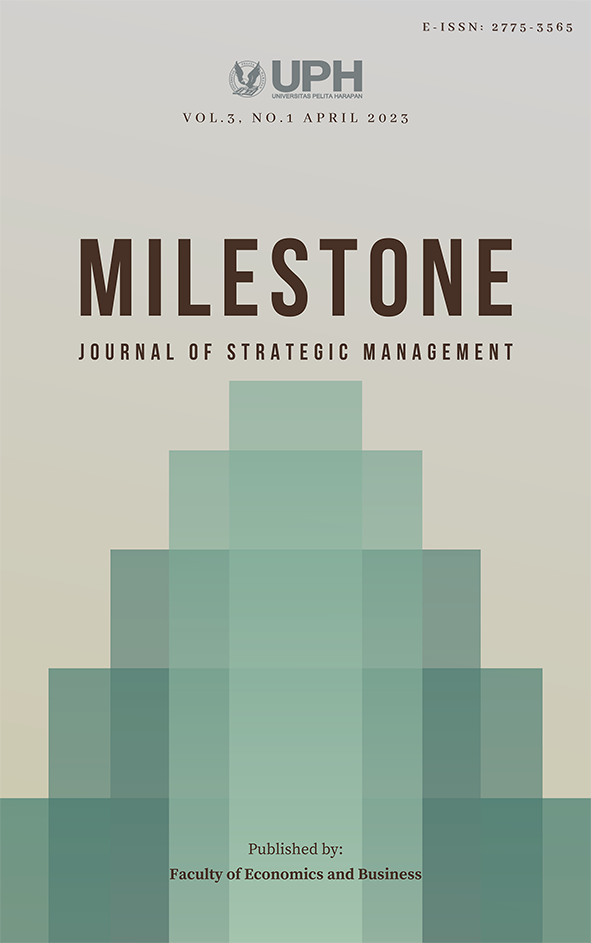THE COMPETITIVE ADVANTAGE OF SIDO MUNCUL: USING PESTLE, PORTER’S FIVE FORCES, AND SWOT MATRIX ANALYSIS
DOI:
https://doi.org/10.19166/ms.v3i1.6919Keywords:
Sido Muncul, PESTLE, Porter’s Five Forces, SWOT MatrixAbstract
Sido Muncul is a company engaged in herbal medicine, pharmaceutical, traditional medicine, health food and beverage, cosmetics, and herbal processing. It is continuously innovating its products and keeping an eye on market needs. Sido Muncul gains a place in the hearts of consumers and is one of its business strategies. In addition, Sido Muncul is also expanding into foreign markets to market and sell its products. This study uses the description of PESTLE analysis, Porter 5 Forces, and SWOT Matrix because it experiences significant challenges from competitors, regulations, the economy, internal companies, and changes in consumer behavior. Based on the PESTLE, Porter 5 Forces, and SWOT Matrix analysis, Sido appears to have strength in market growth and has unique products and competencies to survive in competition, gain profits and continue improving efficiency and product innovation. The company needs to improve: the younger generation does not use herbal products for health.
References
Fiorenita, F., & Dwianika, A. (2021). Penerapan five porter analysis pada efektifitas kelangsungan usaha pelaku UKM (Studi kasus UD Rey Collection). JSMA (Jurnal Sains Manajemen dan Akuntansi), 13(1), 37-47. https://doi.org/10.37151/jsma.v13i1.56
Foris, J., & Mustamu, P. H. R. (2015). Analisis strategi pada perusahaan plastik dengan porter five forces. Agora, 3(1), 736-741. https://publication.petra.ac.id/index.php/manajemen-bisnis/article/view/2986
Koe, T. (2020, April 14). COVID-19 is not stopping Indonesian giant Sido Muncul’s expansion plans and production rates. Nutra Ingredients Asia. https://www.nutraingredients-asia.com/Article/2020/04/08/COVID-19-not-stopping-Indonesian-giant-Sido-Muncul-s-expansion-plans-and-production-rates
Lontoh, R. D., & Mangantar, Y. M. M. (2017). Analisis perbandingan kinerja. Jurnal EMBA, 5(2), 393-403.
Morissan. (2012). Metode penelitian survei. Kencana.
Namugenyi, C., Nimmagadda, S. L., & Reiners, T. (2019). Design of a SWOT analysis model and its evaluation in diverse digital business ecosystem contexts. Procedia Computer Science, 159, 1145-1154. https://doi.org/10.1016/j.procs.2019.09.283
Paramadita, S., Umar, A., & Kurniawan, Y. J. (2020). Analisa pestel terhadap penetrasi Gojek di Indonesia. Jurnal Pengabdian dan Kewirausahaan, 4(1). https://doi.org/10.30813/jpk.v4i1.2079
Pradono, J., & Sulistyowati, N. (2013). Hubungan antara tingkat pendidikan, pengetahuan tentang kesehatan lingkungan perilaku hidup sehat dengan status kesehatan studi korelasi pada penduduk umur 10-24 tahun di Jakarta Pusat. Buletin Penelitian Sistem Kesehatan, 17(1), 89-95.
Qanita, A. (2020). Analisis strategi dengan metode SWOT dan QSPM (Quantitative Strategic Planning Matrix): Studi kasus pada D’Gruz Caffe di kecamatan Bluto Sumenep. Komitmen: Jurnal Ilmiah Manajemen, 1(2), 11-24. https://doi.org/10.15575/jim.v1i2.10309
Sari, R. P., Mariam, I., & Sinaga, M. O. (2021). Analisis strategi pengembangan bisnis melalui matriks SWOT pada startup makanan halal.id. Journal of Management and Business Review, 18(3), 630-639. https://doi.org/10.34149/jmbr.v18i3.219
Sido Muncul. (2022). Annual report 2022. https://investor.sidomuncul.co.id/misc/ar/AR-2022.pdf
Sido Muncul. (2023a). Laporan tahunan 2022. https://investor.sidomuncul.co.id/id/annual_reports.html
Sido Muncul. (2023b). Presentasi perusahaan. https://investor.sidomuncul.co.id/id/corporate_presentation.html
Sido Muncul. (2023c). Research & development. https://www.sidomuncul.co.id/en/research_development.html
Stefani, T. (2021). Analisis strategi pengembangan bisnis menggunakan analisis SWOT dan QSPM (Studi kasus pada V Management Depok). Jurnal Ilmiah Mahasiswa FEB Universitas Brawijaya, 9(1), 1-19. https://jimfeb.ub.ac.id/index.php/jimfeb/article/view/7040
Yüksel, I. (2012). Developing a multi-criteria decision-making model for PESTEL analysis. International Journal of Business and Management, 7(24), 52-66. https://doi.org/10.5539/ijbm.v7n24p52
Downloads
Published
Issue
Section
License
Authors who publish with this journal agree to the following terms:
1) Authors retain copyright and grant the journal right of first publication with the work simultaneously licensed under a Creative Commons Attribution License (CC-BY-SA 4.0) that allows others to share the work with an acknowledgement of the work's authorship and initial publication in this journal.
2) Authors are able to enter into separate, additional contractual arrangements for the non-exclusive distribution of the journal's published version of the work (e.g., post it to an institutional repository or publish it in a book), with an acknowledgement of its initial publication in this journal.
3) Authors are permitted and encouraged to post their work online (e.g., in institutional repositories or on their website). The final published PDF should be used and bibliographic details that credit the publication in this journal should be included.





